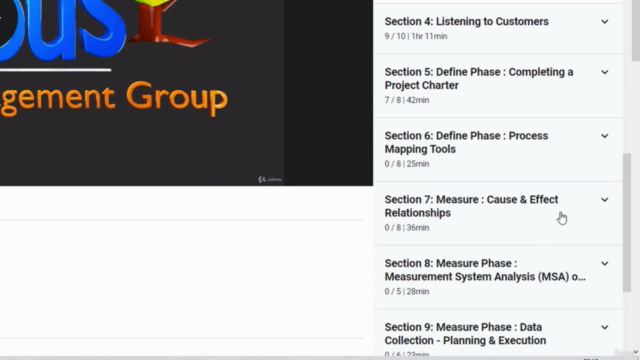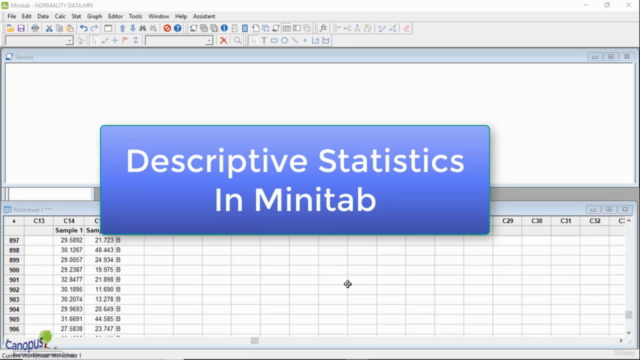Lean Six Sigma Green Belt Online Course (2023)

Why take this course?
- Improve - Generating & Screening Solutions
Approach to Solution Generation:
- The goal is to generate ideas that address the problem or opportunity at hand.
- This can be done through various techniques, such as brainstorming, lateral thinking, and creative problem-solving methods.
Definition and Types of Lateral Thinking:
- Lateral thinking is a process of creative problem-solving which seeks to avoid typical patterns of thinking in order to find novel solutions.
- Edward de Bono popularized the concept of lateral thinking.
- It involves looking at a complex problem from different perspectives, questioning assumptions, and considering factors that may not be immediately obvious.
Edward De Bono:
- A psychologist and author who introduced the concept of lateral thinking.
- His approach emphasizes looking beyond the conventional solutions to find innovative approaches.
- He introduced the idea of using random stimuli to encourage non-linear thinking.
Unstructured Brainstorming:
- A freewheeling, non-judgmental session where participants try to come up with as many ideas as possible.
- It encourages spontaneous contributions from all members of the group and is less structured in terms of rules or guidelines.
Structured Brainstorming:
- More systematic than unstructured brainstorming, often involving specific stages such as goal setting, idea generation, and evaluation.
- Techniques like SCAMPER (Substitute, Combine, Modify, Put to another use, Eliminate, Reverse, and Question) can be used here.
Solution Screening Techniques:
- Criteria are established based on the problem's goals and constraints.
- Ideas are then filtered or screened against these criteria to determine their viability.
N/3 Voting:
- A group decision-making technique where every participant votes for their top idea (or solution).
- The idea with the most votes is considered the group's selection, provided it receives more than one-third of the total votes.
Pay Off Matrix:
- A tool that helps to evaluate ideas based on multiple criteria.
- It allows for a comparison of ideas across various aspects such as cost, ease of implementation, impact, etc.
Criteria Based Matrix (CBM):
- A decision-making technique that evaluates solutions against specific criteria.
- Each criterion is weighted based on its importance to the problem at hand.
Failure Modes, Effects, and Criticality Analysis (FMECA) or Failure Modes, Effects, and Criticality Evaluation (FMECE):
- An analysis method that examines all possible ways a system can fail and evaluates the effects and criticality of each potential failure.
- It is a structured version of FMEA (Failure Mode and Effects Analysis).
Risk Priority Number (RPN):
- A number used in risk management to assess the risk associated with each identified failure mode.
- RPN is calculated by multiplying three factors: Severity (S), Occurrence (O), and Detection (D).
Severity Rating Scale:
- A scale used in FMEA to rank the consequences of a failure mode.
- Typically, it ranges from 1 (least severe) to 10 (most severe).
Occurrence Rating Scale:
- A scale used in FMEA to estimate how often a failure mode is likely to occur.
- Also typically ranging from 1 (least likely) to 10 (most likely).
Detection Rating Scale:
- A scale used in FMEA to assess the probability of detecting a failure before it reaches the customer.
- Similar to the Severity and Occurrence scales, it ranges from 1 (most detectable) to 10 (least detectable).
Risk Mitigation Strategies:
- Once risks are identified and prioritized using FMEA or FMECA, appropriate strategies are developed to mitigate these risks.
- These can include design changes, process modifications, additional testing, or implementing safeguards.
Control Plan:
- A document that outlines the actions required to monitor and control a process to ensure consistent quality and conformance to requirements.
- It includes specifications for monitoring, inspection, and testing procedures, as well as corrective actions to be taken when out-of-control conditions are detected.
Statistical Process Control (SPC):
- A method of quality control which employs statistical methods to monitor and control a process.
- The goal is to ensure the process operates within specified parameters and to identify any shifts or trends that might indicate a change in process stability or capability.
Control Charts:
- Graphical tools used in SPC to determine if a process is producing products or results within acceptable limits.
- They help in identifying when a process has shifted out of control, enabling corrective actions to be taken promptly.
Guidelines for Stability Tests:
- Before implementing control charts, it's essential to ensure that the process is stable and capable.
- This involves collecting samples over time to determine if the process exhibits random variation without any identifiable patterns or trends.
Statistical Validation of Improvements:
- After implementing changes, the effectiveness of these improvements should be validated statistically.
- This can involve re-evaluating control charts and capability analysis to ensure that the process now meets the desired quality standards.
Project Documentation:
- All aspects of the project, from initial problem definition to final solution implementation and validation, should be documented thoroughly.
- This includes any changes made, the reasons for those changes, and evidence that the new process is stable and capable.
Benefits:
- Effective documentation provides a clear record of what was done and why, which can be invaluable for future reference or audits.
- It allows for the transfer of knowledge to new team members or stakeholders, and it contributes to continuous improvement efforts.
Project Closure:
- The final step in the project lifecycle where all activities are completed, and the project is formally ended.
- This includes ensuring that all improvements are implemented, the process is stable, and the project's benefits are realized.
- A translation or transfer plan may also be necessary to ensure that any knowledge, lessons learned, and best practices are carried forward into future projects or business as usual (BAU) operations.
Course Gallery




Loading charts...
Comidoc Review
Our Verdict
Designed for the CSSGB certification, the Lean Six Sigma Green Belt Online Course (2023) is an extensive, informative, and engaging learning experience. With its real-life examples and hands-on Minitab approach to problem-solving, this course provides substantial value. While minor improvements in content delivery can elevate the overall quality, it remains a valuable source of Lean Six Sigma Green Belt knowledge for both beginners and professionals.
What We Liked
- Comprehensive coverage of Lean Six Sigma techniques with 16+ hours of content, helping to solve real-life business problems and perform various data analyses using Minitab
- A highly-praised training example format that effectively connects the course material to the practical world
- High-quality slides, positively emphasized by learners for overall presentation
- Real world examples and a case study throughout the course keep the content engaging
- Knowledgeable instructor, providing suitable and relevant information with examples
Potential Drawbacks
- A few learners mentioned that some advanced statistical methods need further clarification for easier understanding
- Lecture structure can be improved to avoid unwanted discussions, making it less monotonous for visual learners
- Inconsistencies in Spanish translations and synchronization with the audio causing confusion for non-English speakers
- Minitab not being available on macOS may pose issues for some students during statistical analysis tasks
- Limited explanations provided for quiz problems, making it hard to understand and rectify incorrect answers